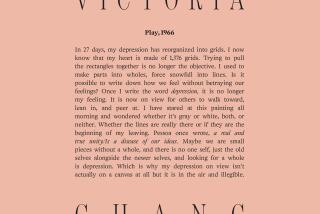‘Falling Into the Fire’ a piercing portrait of psychiatry
Lauren swallows scissors, light bulbs, batteries, bedsprings, knives. Eddie pinches pennies for plastic surgeries he can’t afford and rubs his face raw with sandpaper trying to fix disfiguring acne scars that no one else sees. Colin feels love emanating from everything. Wide-eyed and unshowered, he’s “having trouble communicating my life journey to others.”
They all appear in Dr. Christine Montross’ thoughtful and deeply compassionate new book, “Falling Into the Fire.” Their stories raise questions about the “baffling intersection of the mind and body,” where causes of suffering are mysterious and often there is no end in sight.
What does a good psychiatrist do, asks Montross, when she encounters someone like Lauren or Eddie or Colin? “How do we respond when a patient’s suffering breeds unbearable discomfort and unease within our own selves? What do we do when our patients’ symptoms do not relent? When their experiences cannot be accounted for — or helped by — what we know about medicine, or the brain? What then?”
FOR THE RECORD:
“Falling Into the Fire”: A review in the July 28 Arts & Books section of the book “Falling Into the Fire” by Christine Montross said that one chapter referred to the amputation of a healthy limb as the only cure for body dysmorphic disorder, or BDD. The correct reference was to Body Integrity Identity Disorder, or BIID. —
Montross is assistant professor of psychiatry and human behavior at the Warren Alpert Medical School of Brown University and an inpatient psychiatrist “on the locked wards” of a psychiatric hospital. Her first book, “Body of Work,” was a lucid reflection on dissecting a human cadaver and becoming a medical doctor. Her new book chronicles her residency in psychiatry and her first years as a newly minted psychiatrist. It is a fluid meditation on the limits of medicine and how Montross learned to care for “people nearly all of whom are in profound moments of crisis.”
Each chapter begins with an encounter between Montross and a patient, then launches into an investigation of medicine and history inspired by that patient’s illness. Montross seamlessly weaves together history, reportage and memoir while reflecting on the difficult questions that arise as she digs into psychiatry’s past and interviews experts from its present.
In Eddie’s chapter, we learn about body dysmorphic disorder, or BDD, and how the only “cure” is often the amputation of a perfectly healthy limb, which puts the doctor’s oath to “do no harm” in direct conflict with the mandate to heal. In Colin’s chapter, we learn about historical views of ecstasy and psychosis, and wonder whether modern medicine allows room for religious experience.
Comparisons to Oliver Sacks may be unavoidable, but “Falling Into the Fire” does not read like the medical mysteries that made Sacks famous. This is not a doctor puzzling clues together like some real-world Dr. House; this is a doctor struggling to sit with the uncomfortable questions that arise when medicine doesn’t have any answers.
Lauren, who has been admitted to the ER for swallowing a knife, baffles Montross at first. “Lauren met each of our encounters with derision… I was floundering, and I was sure she could see it.” Lauren humiliates and confuses Montross, who is unsparing in her self-assessment: “My anticipation of her discharge did not mean I had some fantasy that she would get better once she left. It was a marker only of the fact that I wouldn’t have to be involved in her care any longer.”
Lauren’s case illuminates the paradox of finding relief from psychic pain through physical pain, as well as how “these patients bring up ethical quandaries and complicated emotional responses for the doctors involved in their care.”
Remarkably, none of these patient’s stories is resolved with a clear diagnosis, a recovery, or an end, really, at all. Just as Montross is beginning to get a glimpse of why Lauren might have a history of swallowing dangerous objects, her recalcitrant patient is discharged from the ER. She has not been saved. She has not been cured.
Montross repeatedly steers straight toward ambiguity and doubt — about herself as a doctor and about psychiatry in general. This approach echoes the ambiguity of an inherently uncertain medicine. Practicing psychiatry is not like dealing with bacterial infections or broken bones. The causes of psychiatric disorders are often mysterious; the time course of these diseases is different; often there is no obvious cure. For the surgical patient discharged from the hospital the crisis has passed, but for the psychiatric patient, crisis is always lurking around the corner.
Perhaps, Montross suggests, the best tool at her disposal is empathy. Anna is terrified by urges to kill her own 15-month-old son, and while Montross has “never before felt this degree of unremitting fear,” she remembers standing in a boat once holding her infant daughter, afraid she might drop her. Warily, she builds a bridge between her experience and that of her patient.
But sometimes the mind is too shattered, the patient’s experience too foreign. Sometimes, Montross discovers, it is her job to overcome “the inherent discomfort doctors have with helplessness.” This requires a different sort of empathy. As one fellow doctor puts it: “can I be there — really be with you — as you are suffering?”
Crist is writer-in-residence in Biological Sciences at Columbia University. She is working on a book about traumatic brain injury.
Falling Into the Fire
A Psychiatrist’s Encounters With the Mind in Crisis
Christine Montross
Penguin Press: 239 pp., $25.95
More to Read
Sign up for our Book Club newsletter
Get the latest news, events and more from the Los Angeles Times Book Club, and help us get L.A. reading and talking.
You may occasionally receive promotional content from the Los Angeles Times.






